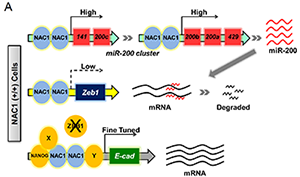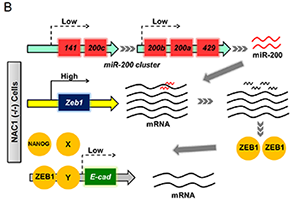| Location: Home>News>Events |
| NAC1: A Novel Inducer of Pluripotency |
|
|
In an effort to further shed light on the mechanisms of somatic cell reprogramming, scientists from the Research Center for Eco-Environmental Sciences, Chinese Academy of Sciences, in Beijing, and the Icahn School of Medicine at Mount Sinai in New York, uncovered the transcription factor Nac1, as a novel reprogramming factor. Their findings have been published on Stem Cell Reports. Pluripotency is the ability of a single type of cells to differentiate into all the cells of an adult body. Typical pluripotent cells are embryonic stem cells (ESCs) and induced pluripotent stem cells (iPSCs). The former are derived from the blastocyst in early mammalian embryos, while the latter from terminally differentiated cells, such as skin fibroblasts, upon nuclear reprogramming. The reprogramming process will convert those somatic and generally unipotent (only able to replicate into a singlecell type) cells into a state reminiscent of embryonic stem cells, meaning they will be able to generate the three primary germ layers, endoderm, ectoderm and mesoderm, as well as primordial germ cells, from which all the cell types of the body are derived. Thus iPSCs can potentially replace ESCs, without ethical concerns, in all their applications, including cell-based clinical therapies, disease modeling, drugs screening and toxicological assays, with the advantage of also being patient-specific. Nac1 is a ubiquitously expressed protein originally identified in the nucleus accumbens of the rat brain as a cocaine-inducible gene; it is also over-expressed in several types of cancer. In ESCs, Nac1 is a common interacting partner of, and upstream modulator, for many stem cell factors, including the core pluripotency factors Nanog, Oct4 and Sox2. However, its mechanistic actions in pluripotency are not well defined. In this study, Faiola et al. demonstrated that during reprogramming, the transcription factor Nac1, as shown in Figure 7 from the published manuscript and reproduced here, fine-tuned the expression of the adhesion molecule E-cadherin, whose up-regulation is vital for successful reprogramming to full pluripotency. In addition, Nac1 down-regulated the major E-cadherin repressor Zeb1, directly via transcriptional repression at its gene locus, and indirectly via expression of the miR200 family of microRNAs, known to regulate Zeb1 mRNA levels. The article is available online on the Stem Cell Reports journal (DOI: 10.1016/j.stemcr.2017.07.002)
Working Model for NAC1 Roles during Somatic Cell Reprogramming (A) When NAC1 is expressed, it can activate the expression of the miR-200 cluster and also directly bind the Zeb1 promoter. Both actions would lead to the downregulation of the ZEB1 protein, and consequently fine-tuning of E-cadherin expression by NAC1 itself, NANOG, and possibly other factors (X represents a putative activator, while Y a putative repressor). (B) In the absence of NAC1, Zeb1 expression is high, whereas the miR-200 mRNAs are downregulated. As a consequence, there is very low post-transcriptional repression of Zeb1, and ZEB1 protein can displace transcription activators on the E-cadherin promoter and repress transcription(from Faiola et al., Stem Cell Reports 2017). State Key Laboratory of Environmental Chemistry and Ecotoxicology August 4, 2017 |

